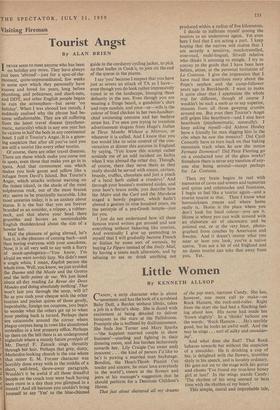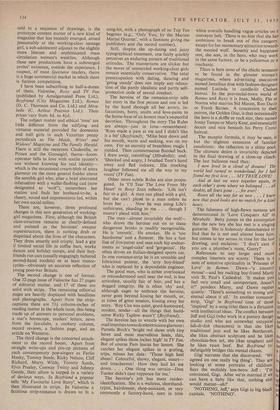Little Women
By KENNETH ALLSOP
CANDY, a strip character who is about seventeen and has the look of a scrubbed Baby Doll, a Bardot without libido, takes a job in a florist's shop. She is dazed with excitement at being detailed to deliver bouquets to the stars at the Pallidrome. Promptly she is buffeted by disillusionment. She finds Joe Turner and Mary Sparks —'the happiest married couple in show business'—snarling and fighting in their dressing room, and Joe lurches lecherously towards her. Lily Craigie ('so sweet and) innocent . . . the kind of person I'd like to be') is pawing a married man backstage. Bondini, the Heart-Throb Pianist ('so tender and sincere, he must love everybody in the world'), sneers at the flowers and jeers at his manager's suggestion that he should perform for a Destitute Children's Home.
That just about shattered all my dreams
of the pop stars, narrates Candy. She has, however, one more call to make—on Rock Hanson, the rock-and-roller. Right from the start she had had a flinching feel- ing about him. His name had made her 'frown slightly'. In a 'thinks' balloon are the words: 'Rock Hanson ... He's terribly good, but he looks an awful wolf. And the way he sings ... sort of sulky and smoulder- ing'.
And what does she find? That Rock behaves towards her without the suspicion of a smoulder. He is drinking a cup of tea, is delighted with the flowers, stumbles shyly in his speech, and is lovably ordinary. He goes out on to the stage with his guitar and chants 'I've found my true-love honey girl at last!' In the wings stands Candy: 'The rhythm of his song seemed to beat time with the rhythm of my heart.'
This simple, moral and improbable tale, told in a sequence of drawings, is the prototype content matter of a new kind of magazine that has recently emerged, aimed presumably at the working-class teenage girl, a sub-adolescent adjunct to the slightly more literate and sophisticated mass circulation women's weeklies. Although these new productions have a submerged
proles' existence, outside the experience, I suspect, of most Spectator readers, theirs is a huge commercial market in which there is furious competition.
I have been subscribing to half-a-dozen of them, Valentine, Roxy and TV Fun (published by Amalgamated Press Ltd.), Boyfriend (City Magazines Ltd.), Romeo (D. C. Thomson and Co. Ltd.) and Mira- belle (C. Arthur Pearson Ltd.). Their prices vary from 4d. to 41.d.
The subject matter and ethical 'tone' are little different from the edifying and virtuous material provided for domestics
and mill girls in such Victorian penny periodicals as The Maids, Wives' and Widows' Magazine and The Family Herald. There is still the recurrent Cinderella, or
Prince and the Goosegirl, theme—loom-
operator falls in love with textile tycoon's son without knowing his real identity—
which is the occasional cream-blob of extra glamour on the more general fodder about the sensible girl who, after a brief abcrrated infatuation with a wallet-flashing cad (now designated as 'wolf'), remembers her station and finds her husband-to-be, a cheery, sound and unpretentious lad, within her own social milieu.
There are, however, three profound changes in this new generation of working- girl magazines. First, although the British class-structure remains as clearly-defined and pointed as the heroines' sweater superstructure, there is nothing drab or dispirited about the lives of the characters. They dress smartly and crisply, lead a gay if limited social life in coffee bars, works dances and holiday camps, and their boy- friends run cars (usually engagingly battered second-hand models) or at least motor- cycles—obviously an accurate reflection of young post-war Britain.
The second change is one of format. One 32-page issue of Valentine has 27 pages
of editorial matter, and 17 of these are solid with strips. The remaining editorial pages are heavily displayed with headlines and photographs. Apart from the strip- captions there are 71i column-inches of reading matter in the whole issue, this being made up of answers to personal problems, a star's horoscope, readers' letters, news from the fan-clubs, a cookery column, record reviews, a fashion page, and an article on Westerns.
The third change is the concerted attach- ment to the record boom. Apart from straight write-ups and pin-up pictures of such contemporary pop-singers as Ferlin Husky, Tommy Steele, Ricky Nelson, Cliff Richard, Marty Wilde, Tommy Sands, Elvis Presley, Conway Twitty and Johnny Gentle, their allure is tapped in a variety of devious ways. In Boyfriend a popster tells 'My Favourite Love Story', which is then illustrated in strips. In Valentine a fictitious strip-romance is drawn to fit a
song-hit, with a photograph of its Top Ten begetter (e.g., 'Only You, by the Marino Marini Quartet', with a footnote giving the publishers and the record number).
Still, despite the up-dating and jazzy typographical treatment, one fairly quickly perceives an enduring pattern of traditional
attitudes. The mannerisms are slicker but the mores of unmarried working-class girls
remain essentially conservative. The total preoccupation with dating, dancing and 'going steady' does not imply any relaxa- tion of the partly idealistic and partly self- protective code of sexual conduct.
The heroine of the romance-strip tells her story in the first person and one is led
by the hand through all her errors, in- fatuations, hurts, snubs and love-pains to the home-base of an honest man's respectful devotion. Throughout the story The Rules arc always—just in time—remembered: 'Russ made a pass at me and I didn't like it a bit' (Boyfriend); 'Mike bent down and his mouth, warm and seeking, was on my own. For an eternity of breathless magic I yielded. Then commonsense flooded back. I drew away, trembling' (Mirabelle); and: 'Shocked and angry, I brushed Tom's hand away and fled indoors. His mocking laughter followed me all the way to my room' (TV Fun).
Other more subtle Rules are also propa- gated. In 'I'll Tear The Love From My Heart' in Roxy Joan reflects: 'Life isn't fair to a girl. A man can plead with a girl, but she can't plead to a man unless he loves her . . . Now he was using Life's unfairness, pleading to me . . . though I mustn't plead with him.'
The man—almost invariably the wolf— who draws the heroine out on to these dangerous brinks is readily recognisable. He is 'smooth'. He smokes. He is 'too handsome' and a flatterer. He has a fast line ofjive-patter and uses such hip endear- ments as 'angel-cake' and 'gorgeous'. He often drives an Italian-designed sports car. In one romance-strip he is an unstable and lubricious painter, the 'arty boy-friend' who is replaced by a dependable engineer.
The good man, who is either overlooked or misunderstood until near the end, is less articulate, usually fair of hair, and has a dogged integrity. He is often 'shy' and, although eager to embrace the heroine, never goes beyond kissing her mouth, or, at times of great tension, kissing away her tears. 'Roy Cox was quiet, good-humoured, modest, tender—all the things that hand- some Ricky Taplow wasn't' (Boyfriend).
The heroine has to wrestle with her own mad impulses towards meretricious glamour: Pamela Birch's 'bright red shoes with tiny bows and most marvellous heels, thin, elegant spikes three inches high' in TV Fun. But of course Pam learns her lesson. She catches her elegant spikes in a grating, trips, misses her date: 'Those high heel shoes! Colourful, showy, elegant, smart— and treacherous! How they had let me down. . . . One thing was certain—Don Turner didn't care tuppence for me.'
The heroine's job has mass reader- identification. She is a waitress, shorthand- typist, hairdresser, shop-assistant, or very commonly a factory-hand, seen in trim white overalls handling vague articles on a conveyor belt. There is no hint that she has ambitions to break out of this category, except for her momentary attraction towards the monied wolf. Security and happiness rest, she sees, in the hero, who may work in the same factory, or be a policeman or a mechanic.
There is here none of the chichi nonsense to be found in the glossier women's magazines, where advertising executives named Jonathan dine with fashion-designers named Lucinda in candle-lit Chelsea bistros. In the provincial-town world of Romeo and Roxy it is Joan, Molly, Flo or Norma who marries Sid Mason, Ron Davis or Frank Barnes. A concession to their patron, the Golden Disc, is that occasionally the hero is a skiffle or rock star, then named Jonny Tempo or Marty Kent, and essentially decent and nice beneath his Perry Como haircut.
The escapist formula, it may be seen, is but the slightest extension of familiar conditions: the reflection in a shiny pool. The ultimate desire is invariably depicted in the final drawing of a close-up clinch. The last balloons read thus: I now lived in a cloud of dreams! The world had turned to wonderland, for I had found may first love . . . MY TRUE LOYD And at last we were together again, in each other's arms where we belonged . . . all doubts, all fears gone . . . for ever!
Roses all the way for us now . . . I knew now that good looks are no match for a kind heart.
The falseness of high-flown notions are demonstrated in 'Love Conquers All' in Mirabelle. Betty jumps to the assumption that the new boy she has met is a singing guitarist. She is hideously disenchanted to find that he is not and almost loses him, but comes to her senses in time for the last drawing, and exclaims: 'I don't care if you are a plumber's mate, Garry!'
References to any larger and more 1 complex interests are scanty. There is a I note of tentative spirituality in 'Prisoner of Love' in Romeo. Dawn—`a country mouse'—and her rocking boy-friend Marty z visit St. Paul's Cathedral. 'It makes you t feel very small and unimportant, doesn't t it?' ponders Marty, and Dawn replies c quietly: 'There's something so strong and eternal about it all.' In another romance- strip, 'Gigi' in Boyfriend (one of those c 'inspired' by a song title) there is a flirtation ti with intellectual ideas. The conflict between sl Jeff and Gigi (who work in a pottery design a studio and who are somewhat untypical a lah-di-dah characters) is that she likes d traditional jazz and he likes Beethoven, she likes abstract sculpture and he likes o chocolate-box art, she likes spaghetti and tr he likes roast beef. But Boyfriend in• 11,
defatigably bridges this mental chasm. it Gigi narrates that she discovered: 'We agreed on one really big thing'. They are in looking at some portraits of children•
Says the mulishly low-brow Jeff : ht convinced, Gigi. After we're married if we in can have a baby like that, nothing else U1
would matter--eh?' rti 'NOTHING, Jeff,' says Gigi in big black capitals. 'NOTHING'. ,e1































 Previous page
Previous page